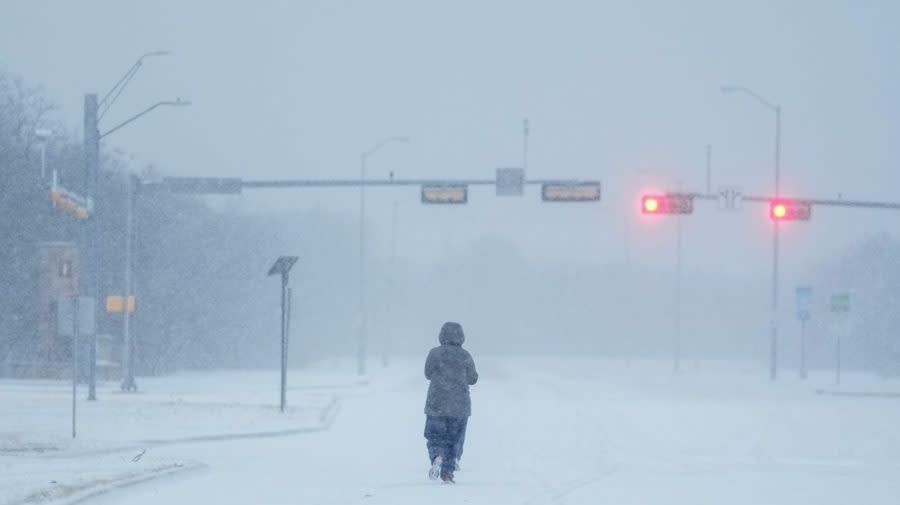How the Texas grid held strong amid freeze and fears of blackout

A blast of arctic cold blowing across Texas early this week fueled fears of widespread blackouts.
But the grid has held strong, protected in large part by the state’s nation-leading renewables industry.
As the sun shone on a chilly Wednesday afternoon, renewable energy sources — wind, solar and nuclear — were responsible for nearly 59 percent of state power supply, according to the Energy Reliability Council of Texas (ERCOT).
By comparison, gas and coal generation contributed about 41 percent.
That’s a major point in favor of wind power, a longtime scapegoat of state conservatives in the wake of the deadly Winter Storm Uri in February 2021, which knocked out power for millions of Texans.
With its hundreds of fatalities and perhaps $300 billion in damages, Uri has hung over every winter — and every record demand-setting summer — ever since, spurring demand for private generators and broader concerns that another four-day blackout would leave millions in unsafe conditions.
Uri also became an emblematic part of a vicious political fight over the Texas energy system — with state progressives largely pointing to failures in the state’s un-winterized natural gas pipelines and power supply, and conservatives blaming the booming wind and solar industry that the state GOP had helped establish.
More Weather and Sustainability coverage from The Hill
Plastics pollution led to $250 billion in disease over one year
Study finds microplastics in nearly all American proteins: meat, fish and plants
Americans abandoning neighborhoods due to rising flood risk, study finds
Bottled water contains hundreds of thousands of potentially dangerous plastic fragments: Study
The drop in power from frozen wind turbines proved that “the Green New Deal would be a deadly deal for the United States of America,” Gov. Greg Abbott (R) told conservative talk show host Sean Hannity in the aftermath of the 2021 storm.
Abbott further claimed that it was the failure of wind, not gas, that had “thrust Texas into a situation where it was lacking power in a statewide basis,” though evidence points to the opposite conclusion.
Others went even further. “We should never build another wind turbine in Texas,” state Agriculture Commissioner Sid Miller (R) said after Uri, adding that “those ugly wind turbines out there are among the main reasons we are experiencing electricity blackouts.”
The turbines, Miller concluded, had only one valuable function: “At least they show us where idiots live.”
This sort of rhetoric was central to a 2023 legislative push by the state GOP against the expanding renewables sector — or what conservative activists called “variable generation”.
But that push largely failed. While the 2023 legislature authorized billions in low-interest loans to new gas plants, other anti-renewable measures failed.
Those included bills that would have paid for that gas buildout using state funds, imposed strict new permitting requirements on wind and solar facilities or required at least half of new electric generation to be gas-powered.
Since 2021, investors in Texas have also heavily funded renewables — leading to the state dethroning California in the fall of 2023 as the country’s biggest provider of utility-scale solar power.
Texas currently hosts 14 gigawatts of solar capacity — enough to power more than 10 million households — with 90 more gigawatts (67 million households’ worth) under development, according to research by S&P Global.
Gas proponents argue that wind and solar have a predictable shortfall — and it’s one that’s reflected in ERCOT’s data from the recent freeze.
From 4 to 8 a.m. on Wednesday, as power demand crept up in advance of the morning sun — and state solar supplies — the state grid was dependent on fossil fuels.
With only wind and nuclear energy online from the renewables side, the proportions were flipped compared to the afternoon, in a prelude of the coming night: At 8 am, as solar plants began to deliver, 68 percent of the grid was powered by gas and coal, and just 32 percent by wind and nuclear.
But even then, ERCOT data shows the state could have drawn on wind to keep the lights on if needed: The 17 gigawatts in reserve power available at 8 a.m. was almost equal to the 18.4 gigawatts of electricity the state wind fleet was providing to the grid.
In a whimsical post on the Texas forum on social media site Reddit, one user pointed out on Monday that renewables were playing a critical role, based on ERCOT projections — and that those projections looked rather like a child’s rendering of a Brontosaurus.
“Renewasaurus holding it down,” user a-big-texas-howdy wrote.
For the latest news, weather, sports, and streaming video, head to The Hill.

